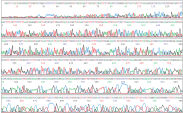✓ 24/7 automatic processing of online orders
✓ Knowledgeable and professional Product & Technical Support
✓ Fast and reliable (re)-ordering
Cat. No. / ID: 63181
✓ 24/7 automatic processing of online orders
✓ Knowledgeable and professional Product & Technical Support
✓ Fast and reliable (re)-ordering
Features
- Fast procedure with only two short centrifugation steps
- Ready-to-use prehydrated gel-filtration material
- Efficient removal of any dye terminator
Product Details
DyeEx Kits provide either spin columns or 96-well plates and use gel-filtration technology to remove dye terminators from sequencing reactions, including reactions for Sanger sequencing. Sequencing reactions are loaded onto the pre-hydrated gel-filtration material. After a short centrifugation step, the reactions are ready to be loaded onto a capillary sequencer. Unincorporated dye terminators are retained in the gel matrix.
Performance
DyeEx Kits remove any type of dye terminator from 10–20 µl sequencing reactions including BigDye, dRhodamine dye, Rhodamine, DYEnamic ET and WellRED terminators. After cleanup, the sequencing reactions can be separated on any capillary sequencer. We recommend the DyeEx 96 Kit using the optimized protocol.
High-quality sequencing
DyeEx Kits are optimized for fast and convenient dye-terminator removal leading to high-quality sequencing results. In contrast, sequencing-reaction cleanup by ethanol precipitation is very time consuming (see table "Comparison of DyeEx procedure and ethanol precipitation") and inefficient. The failure to remove dye terminators efficiently often leads to the appearance of dye blobs in sequencing data making stretches of sequence unreadable. Using DyeEx Kits for sequencing reaction cleanup ensures that the reactions loaded onto sequencing instruments are free of dye terminators. Without dye blobs, the sequence is easily readable throughout (see figure "Superior sequencing results"). Signal intensities are high, resulting in long read lengths (see figure "Long-read sequence").
Comparison of DyeEx procedure and ethanol precipitation
| Procedure | DyeEx 2.0 Spin | DyeEx 96 | Ethanol precipitation |
|---|---|---|---|
| Time required* (12 samples, spin format) | 10 minutes | N.A. | >45 minutes |
| Time required*† (Microplate format for 96 samples) | N.A. | 18 minutes | >60 minutes |
| Handling | Ready-to-use spin format | Ready-to-use | Multiple pipetting steps |
| Sequence quality | ++ | ++ | + |
N.A.: not applicable
* Does not include time required to dry down samples before gel loading (where applicable).
† Using the standard protocol.
See figures
Principle
The DyeEx procedure uses gel filtration to quickly and efficiently remove unincorporated terminators from sequencing reactions. Removal of dye terminators is important to prevent the unincorporated dye terminators from interfering with analysis of sequencing results. The DyeEx gel-filtration material consists of spheres with uniform pores and separates molecules according to molecular weight. When sequencing reaction mixtures are applied to DyeEx columns, dye terminators diffuse into the pores and are retained in the gel-filtration material, while labeled DNA fragments are excluded and recovered in the flow-through (see figure "DyeEx separation principle").
See figures
Procedure
Dye-terminator removal with DyeEx Kits is fast because the procedure is so simple (see flowcharts "DyeEx 2.0 Spin procedure" and ”DyeEx 96 Kit procedure”). A quick centrifugation step removes storage buffer from the columns or wells, the sequencing samples are loaded and a second centrifugation step removes unincorporated dye terminators. Samples are then ready for direct loading onto a capillary sequencer or can be dried, redissolved and loaded onto a sequencing gel.
See figures
Applications
DyeEx Kits remove any type of dye terminator from 10–20 µl sequencing reactions including BigDye, dRhodamine dye, Rhodamine, DYEnamic ET and WellRED terminators. After cleanup, the sequencing reactions can be separated on any capillary sequencer. Signal intensities are high, resulting in long read lengths.
DyeEx Features
| Features | DyeEx 2.0 Spin Kit and DyeEx 96 Kit |
|---|---|
| Binding capacity | 10–20 µl |
| Elution volume | 10–20 µl |
| For DyeEx Kits: | Terminator removal, ABI PRISM 377, 373, 310, 3100, or 3700, MegaBACE 1000, or CEQ 2000 sequencers |
| Format | Tube (DyeEx 2.0 Spin Kit), 96-well plate (DyeEx 96 Kit) |
| Processing | Manual |
| Removal <10mers 17–40mers dye terminator proteins | Dye terminator |
| Sample type | Sequencing reactions |
| Technology | Gel filtration |
DyeEx Kits are intended for molecular biology applications. These products are not intended for the diagnosis, prevention, or treatment of a disease.
Supporting data and figures
Superior sequencing results.







